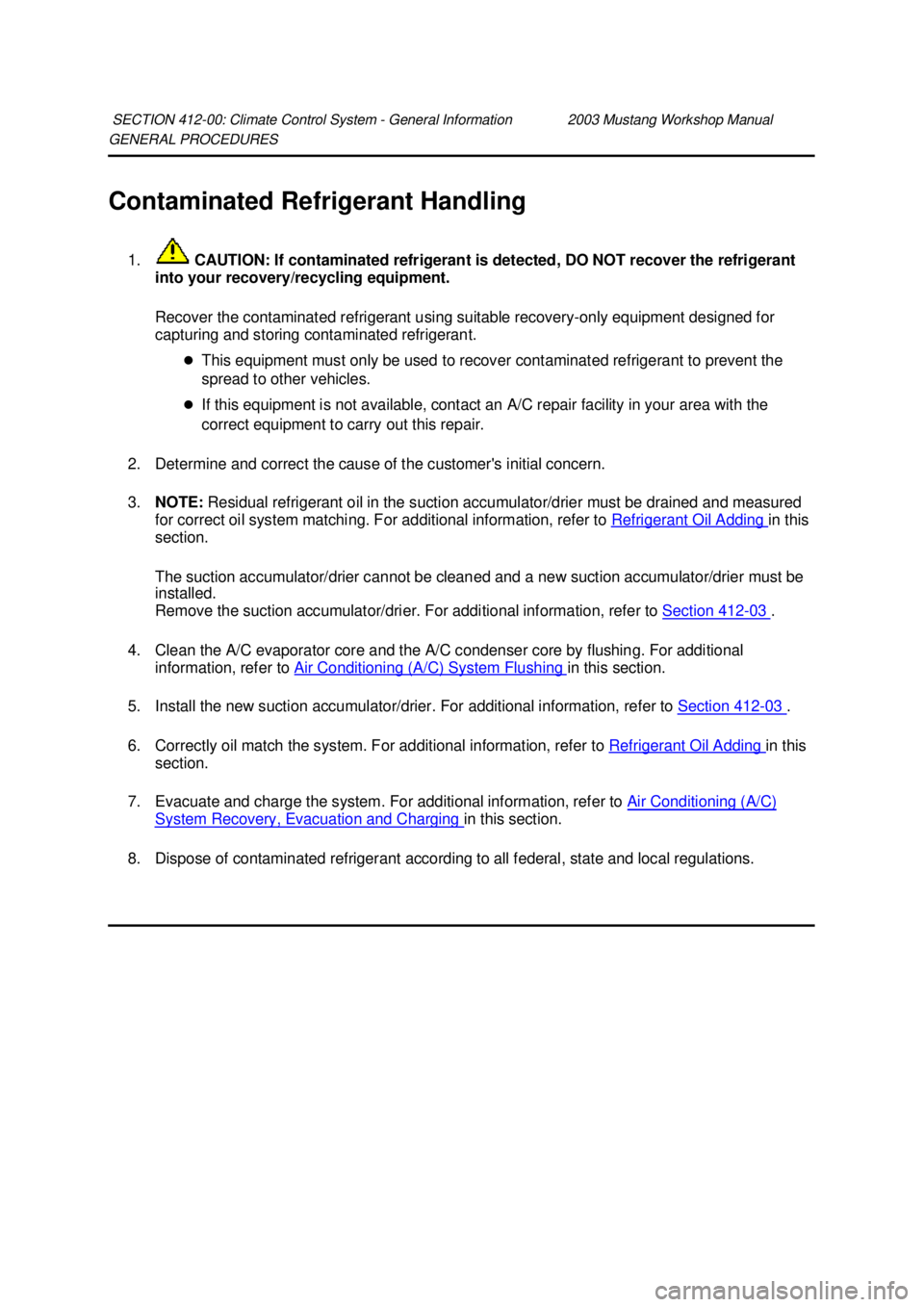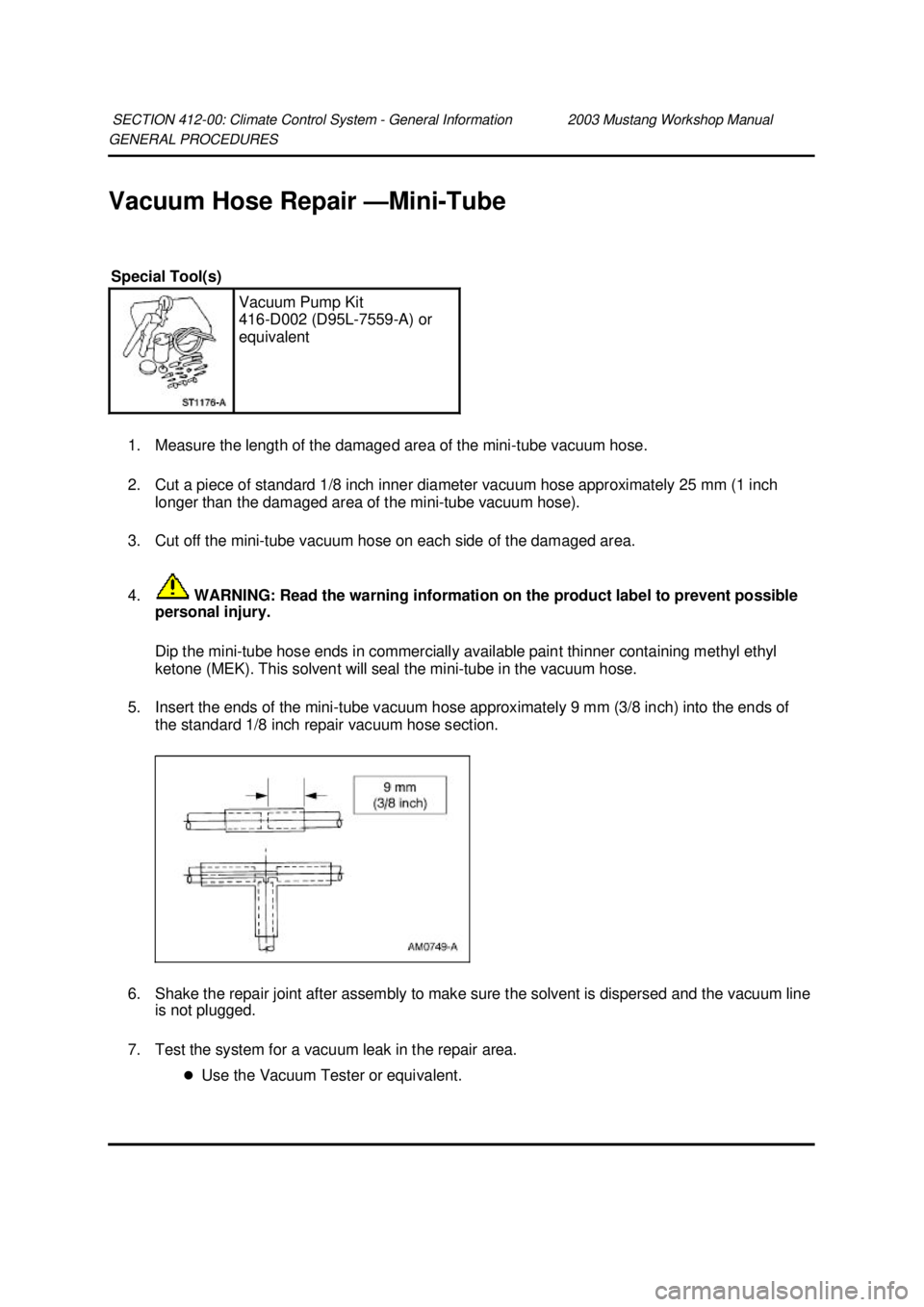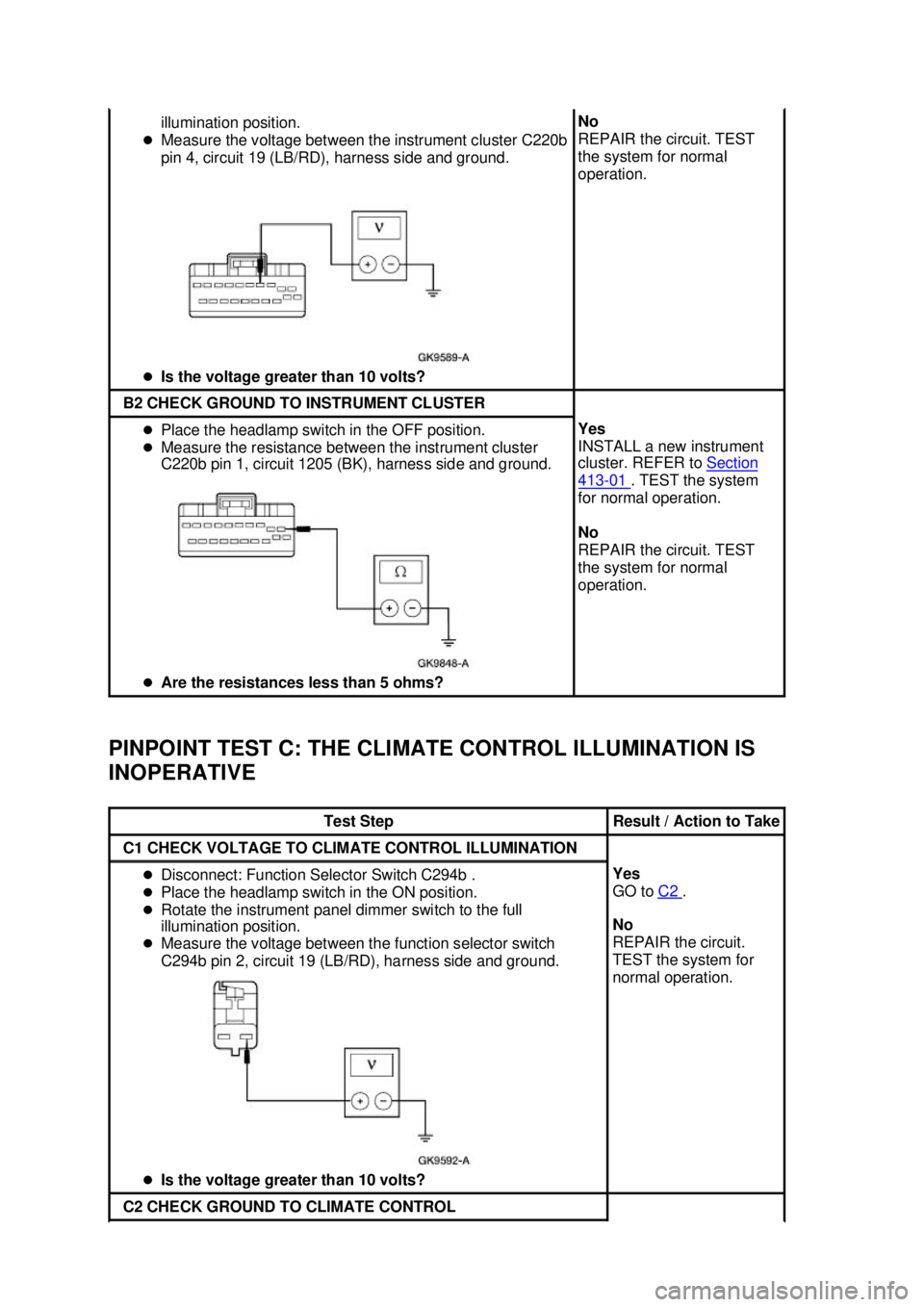Page 3131 of 4378

GENERAL PROCEDURES
Contaminated Refrigerant Handling
1. CAUTION: If contaminated refrigerant is detected, DO NOT recover the refrigerant
into your recovery/recycling equipment.
Recover the contaminated refrigerant using suitable recovery- only equipment designed for
capturing and storing contaminated refrigerant.
�zThis equipment must only be used to recover contaminated refrigerant to prevent the
spread to other vehicles.
�z If this equipment is not available, contact an A/C repair facility in your area with the
correct equipment to carry out this repair.
2. Determine and correct the cause of the customer's initial concern.
3. NOTE: Residual refrigerant oil in the suction accumulator/drier must be drained and measured
for correct oil system matching. For additional information, refer to Refrigerant Oil Adding in this
section.
The suction accumulator/drier cannot be cleaned and a new suction accumulator/drier must be
installed.
Remove the suction accumulator/drier. For additional information, refer to Section 412 - 03 .
4. Clean the A/C evaporator core and the A/C condenser core by flushing. For additional information, refer to Air Conditioning (A/C) System Flushing in this section.
5. Install the new suction accumulator/drier. For additional information, refer to Section 412 - 03 .
6. Correctly oil match the system. For additional information, refer to Refrigerant Oil Adding in this
section.
7. Evacuate and charge the system. For additional information, refer to Air Conditioning (A/C) System Recovery, Evacuation and Charging in this section.
8. Dispose of contaminated refrigerant according to all federal, state and local regulations.
SECTION 412-
00: Climate Control System - General Information 2003 Mustang Workshop Manual �K�l�j . 1 �b�a
22003 Mustang Workshop Manual
18. 11. 2011file:///C:/Ford/2000 - 2004/tsocache/SHEF_2308/S3B~us~en~ ...
Page 3133 of 4378

GENERAL PROCEDURES
Vacuum Hose Repair —
Mini-Tube
1. Measure the length of the damaged area of the mini-tube vacuum hose.
2. Cut a piece of standard 1/8 inch inner diameter vacuum hose approximately 25 mm (1 inch longer than the damaged area of the mini- tube vacuum hose).
3. Cut off the mini-tube vacuum hose on each side of the damaged area.
4. WARNING: Read the warning information on the product label to prevent possible
personal injury.
Dip the mini- tube hose ends in commercially available paint thinner containing methyl ethyl
ketone (MEK). This solvent will seal the mini- tube in the vacuum hose.
5. Insert the ends of the mini- tube vacuum hose approximately 9 mm (3/8 inch) into the ends of
the standard 1/8 inch repair vacuum hose section.
6. Shake the repair joint after assembly to make sure the solvent is dispersed and the vacuum line is not plugged.
7. Test the system for a vacuum leak in the repair area. �zUse the Vacuum Tester or equivalent.
SECTION 412-
00: Climate Control System - General Information 2003 Mustang Workshop Manual Special Tool(s)
Vacuum Pump Kit
416-
D002 (D95L-7559- A) or
equivalent �K�l�j . 1 �b�a
22003 Mustang Workshop Manual
18. 11. 2011file:///C:/Ford/2000 - 2004/tsocache/SHEF_2308/S3B~us~en~ ...
Page 3233 of 4378
DESCRIPTION AND OPERATION
Control Components
Manual A/C
The climate control system heats or cools the vehicle interior depending on the function selector
position and the temperature selected. Function selector position determines heating or cooling and air
distribution. The temperature blend control setting determines air temperature.
The manual climate control components are used to:
�zselect air inlet source (outside or recirculated).
�z select blower motor speed.
�z select discharge air temperature (temperature blend).
�z select discharge air location (defrost, panel, floor).
�z select A/C compressor clutch operation. Component Locations SECTION 412-
04: Control Components 2003 Mustang Workshop Manual �K�l�j . 1 �b�a
42003 Mustang Workshop Manual
18. 11. 2011file:///C:/Ford/2000 - 2004/tsocache/SHEF_5108/S3B~us~en~ ...
Page 3234 of 4378
Control System Inputs
Climate Control Assembly
The climate control assembly has three system controls:
�zThe blower motor switch controls blower motor speed by adding or bypassing resistors in the
heater blower motor resistor.
�z The temperature selection is accomplished with a manually- controlled blend door actuator that
controls positioning of the temperature blend door. Movement of the control knob (18519) from Item Part
Number Description
1 18A318 Vacuum control motor (panel/defrost door)
2 19988 Temperature blend door actuator cable
3 18A318 Vacuum control motor (air inlet door)
4 A/C vacuum reservoir tank and bracket (part of
18454)
5 18A318 Vacuum control motor (floor/panel door) �K�l�j . 2 �b�a
42003 Mustang Workshop Manual
18. 11. 2011file:///C:/Ford/2000 - 2004/tsocache/SHEF_5108/S3B~us~en~ ...
Page 3242 of 4378
REMOVAL AND INSTALLATION
Switch
Removal
1. Remove the climate control assembly. For additional information, refer to Control Assembly in
this section.
2. NOTE: All three switches are removed the same.
Remove the knob.
3. Remove the screw.
4. Rotate the switch and remove it from the control head assembly. Installation SECTION 412-
04: Control Components 2003 Mustang Workshop Manual �K�l�j . 1 �b�a
22003 Mustang Workshop Manual
18. 11. 2011file:///C:/Ford/2000 - 2004/tsocache/SHEF_5108/S3B~us~en~ ...
Page 3254 of 4378

Pinpoint Tests
PINPOINT TEST A: THE CONTROL ILLUMINATION IS INOPERATIVE
PINPOINT TEST B: THE INSTRUMENT CLUSTER ILLUMINATION IS
INOPERATIVE �z
Bulb(s).
�z The climate control
illumination is inoperative �z
Circuitry.
�z Bulb(s). �z
Go To Pinpoint Test C .
�z The audio system
illumination is inoperative �z
Circuitry.
�z Audio unit. �z
Go To Pinpoint Test D .
�z A single illumination source
is inoperative �z
Circuitry.
�z Switch. �z
Go To Pinpoint Test E .
Test Step Result / Action to Take
A1 CHECK PARKING LAMPS
�z
Place the headlamp switch in the ON
position.
�z Are the exterior lamps on? Yes
Place the headlamp switch in the OFF position.
GO to
A2 .
No
REFER to Section 417 - 01 .
A2 CHECK HEADLAMP SWITCH
�z
Key in OFF position.
�z Carry out the headlamp switch
components test;
Refer to Wiring Diagrams Cell 149 for
schematic and connector information.
.
�z Is the headlamp switch OK? Yes
RECONNECT the headlamp switch. GO to
A3 .
No
INSTALL a new headlamp switch. REFER to
Section 417 - 01 . TEST the system for normal
operation. A3 CHECK CIRCUIT 1045 (DB/WH)
�z
Place the headlamp switch in the ON
position.
�z Rotate the instrument panel dimmer
switch to the full illumination position.
�z Measure voltage between central
junction box (CJB) fuse 37 (5A) and
ground.
�z Is the voltage greater than 10 volts? Yes
REPAIR circuit 19 (LB/RD). TEST the system for
normal operation.
No
REPAIR circuit 1045 (DB/WH). TEST the system
for normal operation.
Test Step Result / Action to Take
B1 CHECK VOLTAGE TO INSTRUMENT CLUSTER
ILLUMINATION �z
Disconnect: Instrument Cluster .
�z Place the headlamp switch in the ON position.
�z Rotate the instrument panel dimmer switch to the full Yes
GO to
B2 . �K�l�j . 2 �b�a
52003 Mustang Workshop Manual
18. 11. 2011file:///C:/Ford/2000 - 2004/tsocache/SHEF_5108/S3B~us~en~ ...
Page 3255 of 4378

PINPOINT TEST C: THE CLIMATE CONTROL ILLUMINATION IS
INOPERATIVE illumination position.
�z Measure the voltage between the instrument cluster C220b
pin 4, circuit 19 (LB/RD), harness side and ground.
�z Is the voltage greater than 10 volts? No
REPAIR the circuit. TEST
the system for normal
operation.
B2 CHECK GROUND TO INSTRUMENT CLUSTER
�z
Place the headlamp switch in the OFF position.
�z Measure the resistance between the instrument cluster
C220b pin 1, circuit 1205 (BK), harness side and ground.
�z Are the resistances less than 5 ohms? Yes
INSTALL a new instrument
cluster. REFER to
Section 413 - 01 . TEST the system
for normal operation.
No
REPAIR the circuit. TEST
the system for normal
operation. Test Step Result / Action to Take
C1 CHECK VOLTAGE TO CLIMATE CONTROL ILLUMINATION
�z
Disconnect: Function Selector Switch C294b .
�z Place the headlamp switch in the ON position.
�z Rotate the instrument panel dimmer switch to the full
illumination position.
�z Measure the voltage between the function selector switch
C294b pin 2, circuit 19 (LB/RD), harness side and ground.
�z Is the voltage greater than 10 volts? Yes
GO to
C2 .
No
REPAIR the circuit.
TEST the system for
normal operation. C2 CHECK GROUND TO CLIMATE CONTROL �K�l�j . 3 �b�a
52003 Mustang Workshop Manual
18. 11. 2011file:///C:/Ford/2000 - 2004/tsocache/SHEF_5108/S3B~us~en~ ...
Page 3794 of 4378
7. Install the LH front wheel and tire assembly. For additional information, refer to
Section 204 - 04 .
8. Remove the floor console. For additional information, refer to Floor Console in this section.
9. Remove the upper RH instrument panel support bolt.
10. Disconnect the antenna in- line connector.
11. Disconnect the climate control vacuum harness connector.
12. Close the glove compartment. �K�l�j . 2 �b�a
152003 Mustang Workshop Manual
18. 11. 2011file:///C:/Ford/2000 - 2004/tsocache/SHEF_5108/S3B~us~en~ ...